Hilbert-Coding Metasurface for Diverse Electromagnetic Controls
Abstract
:1. Introduction
2. Principle and Design
3. Conclusions
Author Contributions
Funding
Institutional Review Board Statement
Informed Consent Statement
Conflicts of Interest
References
- Chen, H.; Wu, B.I.; Zhang, B.; Kong, J.A. Electromagnetic wave interactions with a metamaterial cloak. Phys. Rev. Lett. 2007, 99, 063903. [Google Scholar] [CrossRef] [PubMed]
- Garcia, N.; Nieto-Vesperinas, M. Left-handed materials do not make a perfect lens. Phys. Rev. Lett. 2002, 88, 207403. [Google Scholar] [CrossRef] [PubMed]
- Jiang, W.X.; Qiu, C.W.; Han, T.C.; Cheng, Q.; Ma, H.F.; Zhang, S.; Cui, T.J. Broadband all-dielectric magnifying lens for far-field high-resolution imaging. Adv. Mater. 2013, 25, 6963–6968. [Google Scholar] [CrossRef] [PubMed]
- Leonhardt, U. Optical conformal mapping. Science 2006, 312, 1777–1780. [Google Scholar] [CrossRef]
- Liu, S.; Jun Cui, T.; Noor, A.; Tao, Z.; Chi Zhang, H.; Dong Bai, G.; Yang, Y.; Yang Zhou, X. Negative reflection and negative surface wave conversion from obliquely incident electromagnetic waves. Light Sci. Appl. 2018, 7, 18008. [Google Scholar] [CrossRef]
- Chen, L.; Ma, Q.; Jing, H.B.; Cui, H.Y.; Liu, Y.; Cui, T.J. Space-Energy Digital-Coding Metasurface Based on an Active Amplifier. Phys. Rev. Appl. 2019, 11, 6. [Google Scholar] [CrossRef]
- Fang, X.; Ren, H.; Gu, M. Orbital angular momentum holography for high-security encryption. Nat. Photonics 2019, 14, 102–108. [Google Scholar] [CrossRef]
- Huang, X.; Lai, Y.; Hang, Z.H.; Zheng, H.; Chan, C.T. Dirac cones induced by accidental degeneracy in photonic crystals and zero-refractive-index materials. Nat. Mater. 2011, 10, 582. [Google Scholar] [CrossRef]
- Cui, T.-J.; Liu, S.; Li, L.-L. Information entropy of coding metasurface. Light Sci. Appl. 2016, 5, e16172. [Google Scholar] [CrossRef]
- Grbic, A.; Eleftheriades, G.V. Experimental verification of backward-wave radiation from a negative refractive index metamaterial. J. Appl. Phys. 2002, 92, 5930–5935. [Google Scholar] [CrossRef] [Green Version]
- Ma, Q.; Mei, Z.L.; Zhu, S.K.; Jin, T.Y.; Cui, T.J. Experiments on Active Cloaking and Illusion for Laplace Equation. Phys. Rev. Lett. 2013, 111, 173901. [Google Scholar] [CrossRef]
- Ma, Q.; Yang, F.; Jin, T.Y.; Mei, Z.L.; Cui, T.J. Open active cloaking and illusion devices for the Laplace equation. J. Opt. 2016, 18, 044004. [Google Scholar] [CrossRef]
- Akselrod, G.M.; Huang, J.; Hoang, T.B.; Bowen, P.T.; Su, L.; Smith, D.R.; Mikkelsen, M.H. Large-Area Metasurface Perfect Absorbers from Visible to Near-Infrared. Adv. Mater. 2015, 27, 8028–8034. [Google Scholar] [CrossRef]
- Díaz-Rubio, A.; Tretyakov, S.A. Acoustic metasurfaces for scattering-free anomalous reflection and refraction. Phys. Rev. B 2017, 96, 125409. [Google Scholar] [CrossRef]
- Liu, C.; Ma, Q.; Luo, Z.J.; Hong, Q.R.; Xiao, Q.; Zhang, H.C.; Miao, L.; Yu, W.M.; Cheng, Q.; Li, L.; et al. A programmable diffractive deep neural network based on a digital-coding metasurface array. Nat. Electron. 2022, 5, 113–122. [Google Scholar] [CrossRef]
- Ma, Q.; Chen, L.; Jing, H.B.; Hong, Q.R.; Cui, H.Y.; Liu, Y.; Li, L.; Cui, T.J. Controllable and Programmable Nonreciprocity Based on Detachable Digital Coding Metasurface. Adv. Opt. Mater. 2019, 7, 1901285. [Google Scholar] [CrossRef]
- Ma, Q.; Bai, G.D.; Jing, H.B.; Yang, C.; Li, L.; Cui, T.J. Smart metasurface with self-adaptively reprogrammable functions. Light Sci. Appl. 2019, 8, 98. [Google Scholar] [CrossRef]
- Ma, Q.; Hong, Q.R.; Gao, X.X.; Jing, H.B.; Liu, C.; Bai, G.D.; Cheng, Q.; Cui, T.J. Smart sensing metasurface with self-defined functions in dual polarizations. Nanophotonics 2020, 9, 3271–3278. [Google Scholar] [CrossRef]
- Ma, Q.; Shi, C.B.; Chen, T.Y.; Qi, M.Q.; Li, Y.B.; Cui, T.J. Broadband metamaterial lens antennas with special properties by controlling both refractive-index distribution and feed directivity. J. Opt. 2018, 20, 045101. [Google Scholar] [CrossRef]
- Ma, Q.; Gao, W.; Xiao, Q.; Ding, L.; Gao, T.; Zhou, Y.; Gao, X.; Yan, T.; Liu, C.; Gu, Z.; et al. Directly wireless communication of human minds via non-invasive brain-computer-metasurface platform. eLight 2022, 2, 11. [Google Scholar] [CrossRef]
- Ma, Q.; Hong, Q.R.; Bai, G.D.; Jing, H.B.; Wu, R.Y.; Bao, L.; Cheng, Q.; Cui, T.J. Editing Arbitrarily Linear Polarizations Using Programmable Metasurface. Phys. Rev. Appl. 2020, 13, 021003. [Google Scholar] [CrossRef]
- Chen, L.; Ma, Q.; Nie, Q.F.; Hong, Q.R.; Cui, H.Y.; Ruan, Y.; Cui, T.J. Dual-polarization programmable metasurface modulator for near-field information encoding and transmission. Photonics Res. 2021, 9, 116–124. [Google Scholar] [CrossRef]
- You, J.W.; Ma, Q.; Lan, Z.; Xiao, Q.; Panoiu, N.C.; Cui, T.J. Reprogrammable plasmonic topological insulators with ultrafast control. Nat. Commun. 2021, 12, 5468. [Google Scholar] [CrossRef]
- Cui, T.J.; Qi, M.Q.; Wan, X.; Zhao, J.; Cheng, Q. Coding metamaterials, digital metamaterials and programmable metamaterials. Light Sci. Appl. 2014, 3, e218. [Google Scholar] [CrossRef]
- Ma, Q.; Cui, T.J. Information Metamaterials: Bridging the physical world and digital world. PhotoniX 2020, 1, 1. [Google Scholar] [CrossRef]
- Ma, Q.; Shi, C.B.; Bai, G.D.; Chen, T.Y.; Noor, A.; Cui, T.J. Beam-Editing Coding Metasurfaces Based on Polarization Bit and Orbital-Angular-Momentum-Mode Bit. Adv. Opt. Mater. 2017, 5, 1700548. [Google Scholar] [CrossRef]
- Liu, S.; Noor, A.; Du, L.L.; Zhang, L.; Xu, Q.; Luan, K.; Wang, T.Q.; Tian, Z.; Tang, W.X.; Han, J.G.; et al. Anomalous Refraction and Nondiffractive Bessel-Beam Generation of Terahertz Waves through Transmission-Type Coding Metasurfaces. ACS Photonics 2016, 3, 1968–1977. [Google Scholar] [CrossRef]
- Xiao, Q.; Ma, Q.; Yan, T.; Wu, L.W.; Liu, C.; Wang, Z.X.; Wan, X.; Cheng, Q.; Cui, T.J. Orbital-Angular-Momentum-Encrypted Holography Based on Coding Information Metasurface. Adv. Opt. Mater. 2021, 9, 2002155. [Google Scholar] [CrossRef]
- Yan, T.; Ma, Q.; Sun, S.; Xiao, Q.; Shahid, I.; Gao, X.; Cui, T.J. Polarization Multiplexing Hologram Realized by Anisotropic Digital Metasurface. Adv. Theory Simul. 2021, 4, 2100046. [Google Scholar] [CrossRef]
- Liu, S.; Zhang, H.C.; Zhang, L.; Yang, Q.L.; Xu, Q.; Gu, J.; Yang, Y.; Zhou, X.Y.; Han, J.; Cheng, Q.; et al. Full-State Controls of Terahertz Waves Using Tensor Coding Metasurfaces. ACS Appl. Mater. Interfaces 2017, 9, 21503–21514. [Google Scholar] [CrossRef]
- Cui, T.J. Microwave metamaterials-from passive to digital and programmable controls of electromagnetic waves. J. Opt. 2017, 19, 084004. [Google Scholar] [CrossRef]
- Yu, N.F.; Genevet, P.; Kats, M.A.; Aieta, F.; Tetienne, J.P.; Capasso, F.; Gaburro, Z. Light Propagation with Phase Discontinuities: Generalized Laws of Reflection and Refraction. Science 2011, 334, 333–337. [Google Scholar] [CrossRef] [PubMed]
- Dong, D.S.; Yang, J.; Cheng, Q.; Zhao, J.; Gao, L.H.; Ma, S.J.; Liu, S.; Chen, H.B.; He, Q.; Liu, W.W.; et al. Terahertz Broadband Low-Reflection Metasurface by Controlling Phase Distributions. Adv. Opt. Mater. 2015, 3, 1405–1410. [Google Scholar] [CrossRef]
- Cui, T.J.; Liu, S.; Zhang, L. Information metamaterials and metasurfaces. J. Mater. Chem. C 2017, 5, 3644–3668. [Google Scholar] [CrossRef]
- Zhang, L.; Wan, X.; Liu, S.; Yin, J.Y.; Zhang, Q.; Wu, H.T.; Cui, T.J. Realization of Low Scattering for a High-Gain Fabry-Perot Antenna Using Coding Metasurface. IEEE Trans. Antennas Propag. 2017, 65, 3374–3383. [Google Scholar] [CrossRef]
- Liu, L.; Zhang, X.; Kenney, M.; Su, X.; Xu, N.; Ouyang, C.; Shi, Y.; Han, J.; Zhang, W.; Zhang, S. Broadband metasurfaces with simultaneous control of phase and amplitude. Adv. Mater. 2014, 26, 5031–5036. [Google Scholar] [CrossRef]
- Zhang, X.; Tian, Z.; Yue, W.; Gu, J.; Zhang, S.; Han, J.; Zhang, W. Broadband terahertz wave deflection based on C-shape complex metamaterials with phase discontinuities. Adv. Mater. 2013, 25, 4567–4572. [Google Scholar] [CrossRef]
- Liu, S.; Cui, T.J.; Zhang, L.; Xu, Q.; Wang, Q.; Wan, X.; Gu, J.Q.; Tang, W.X.; Qing, Q.M.; Han, J.G.; et al. Convolution Operations on Coding Metasurface to Reach Flexible and Continuous Controls of Terahertz. Adv. Sci. 2016, 3, 1600156. [Google Scholar] [CrossRef]
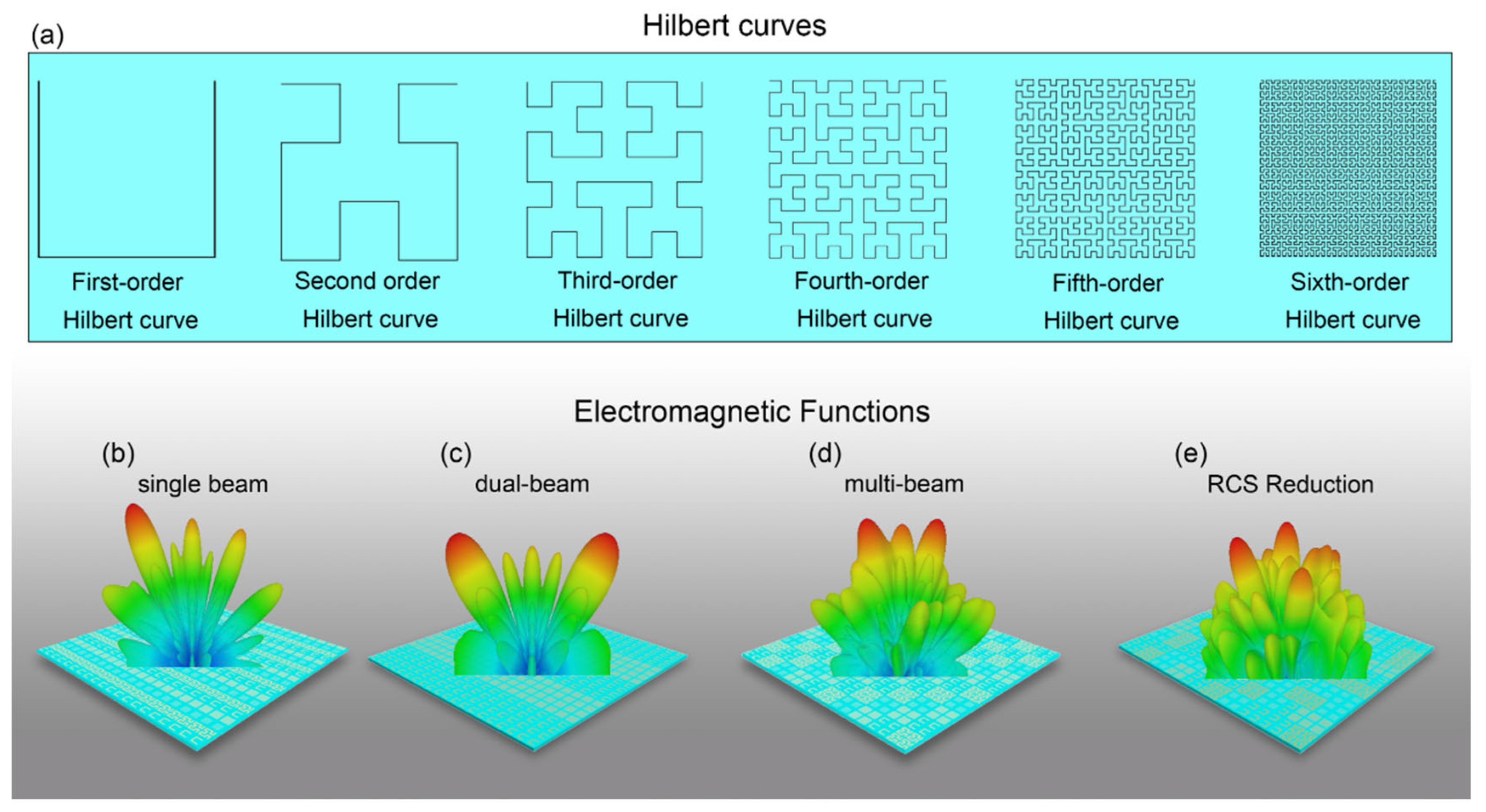
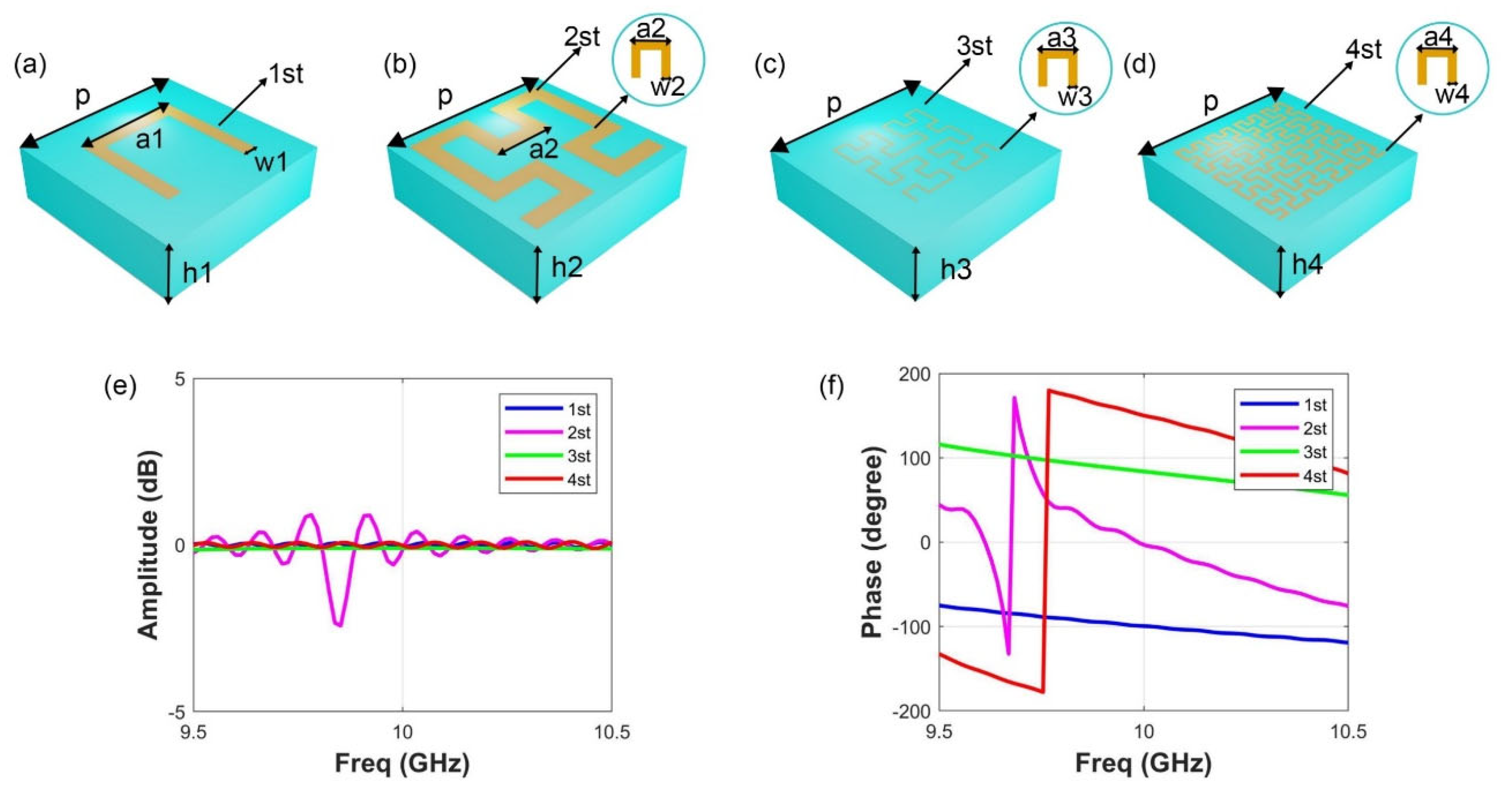
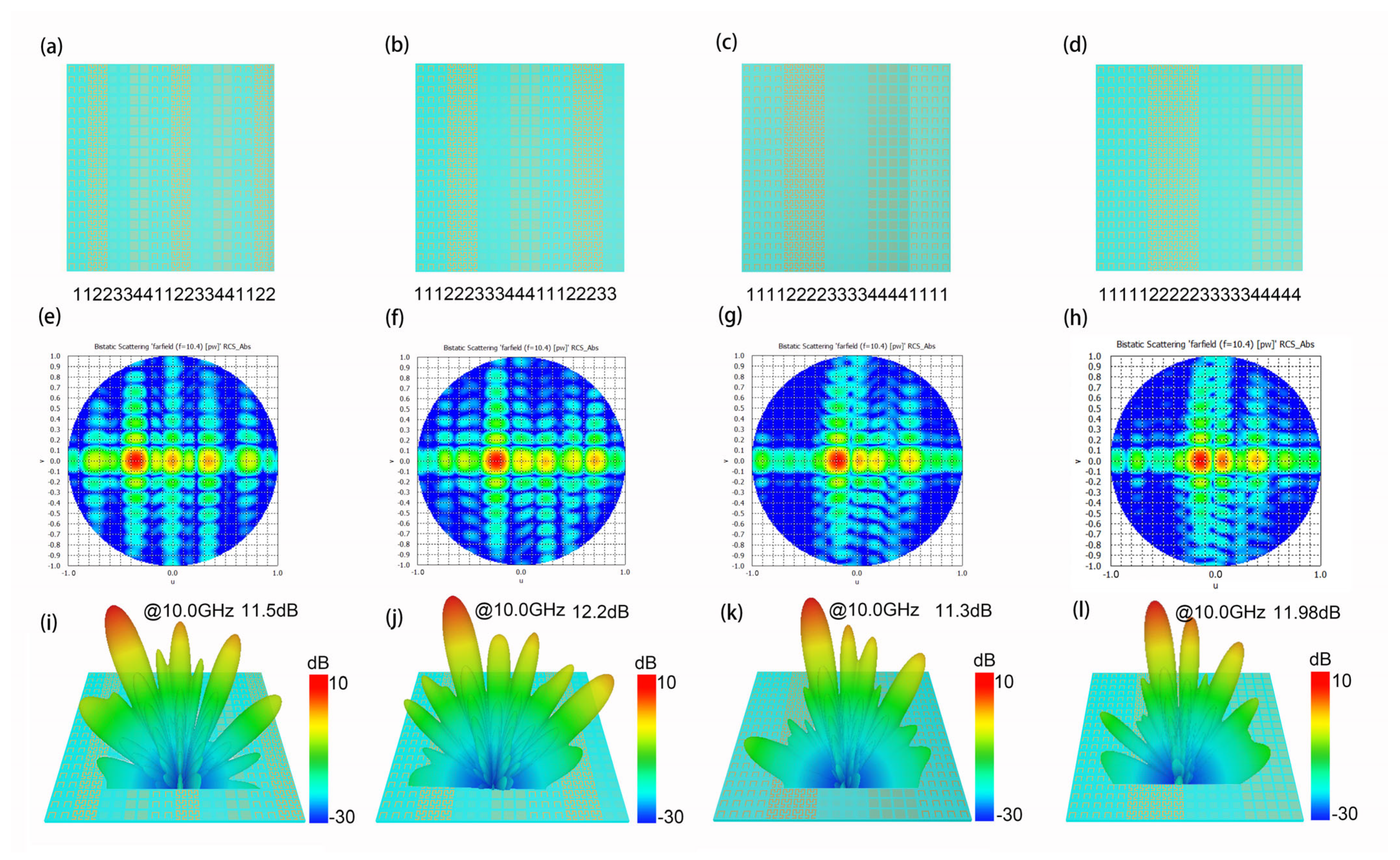
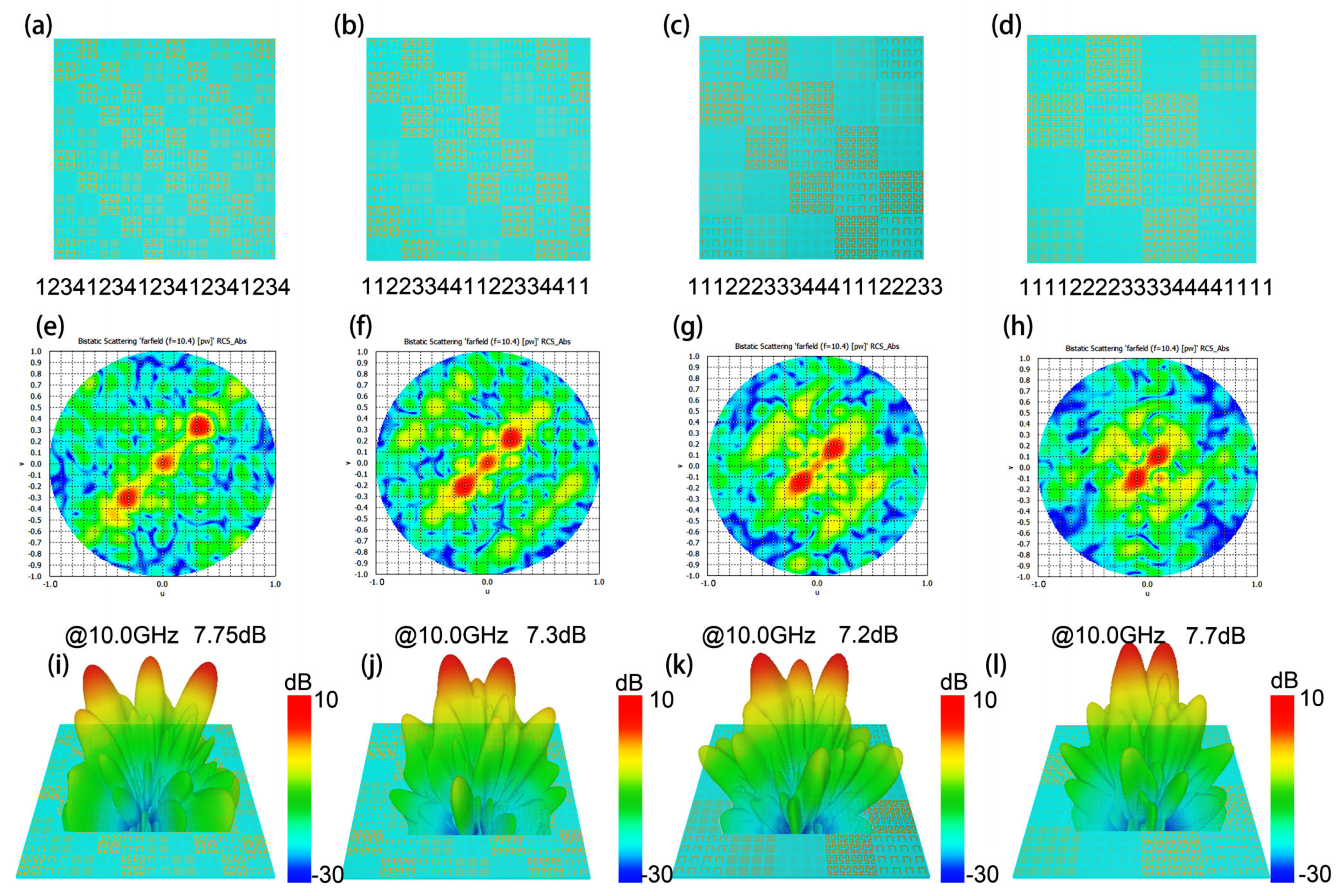
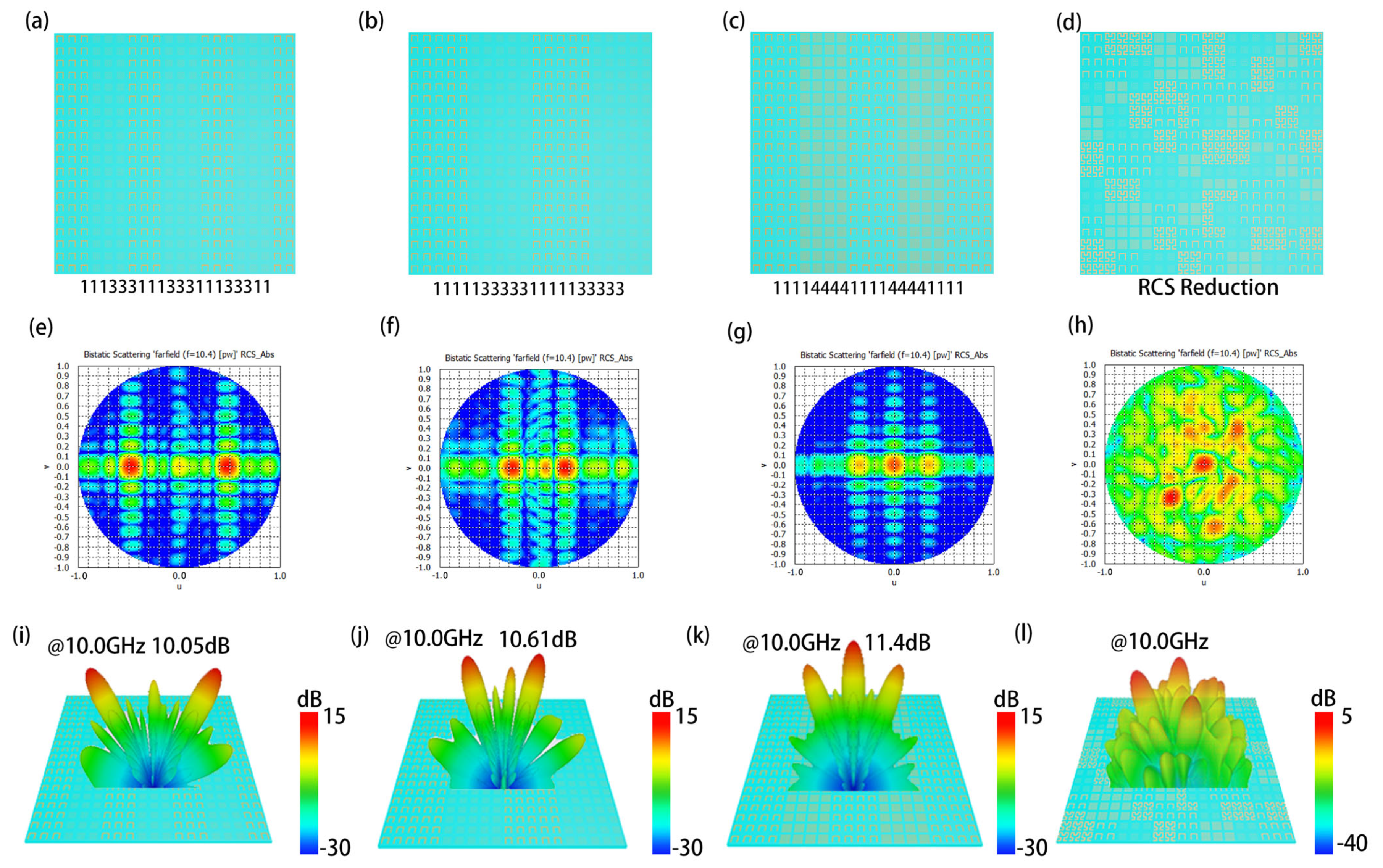
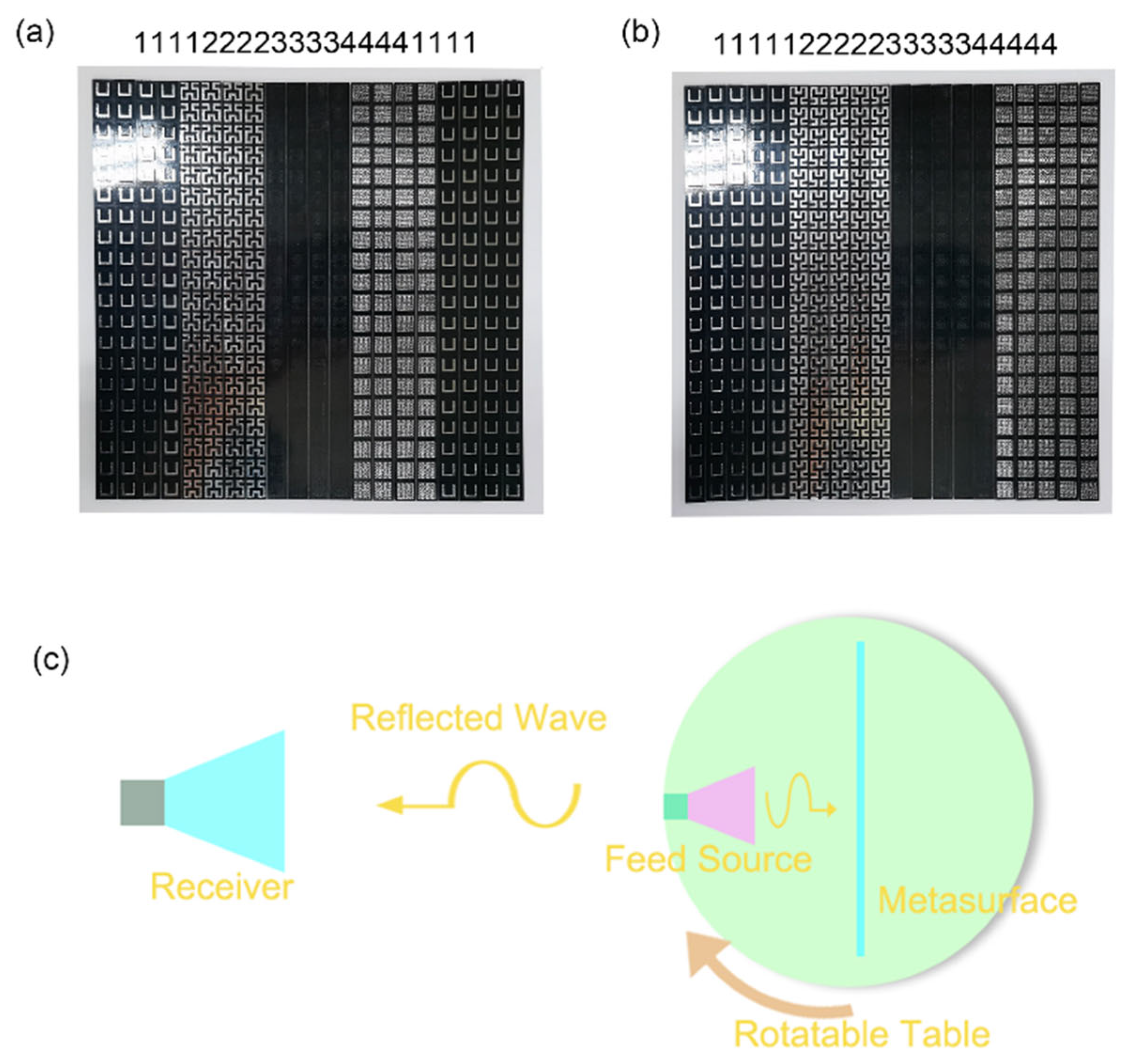
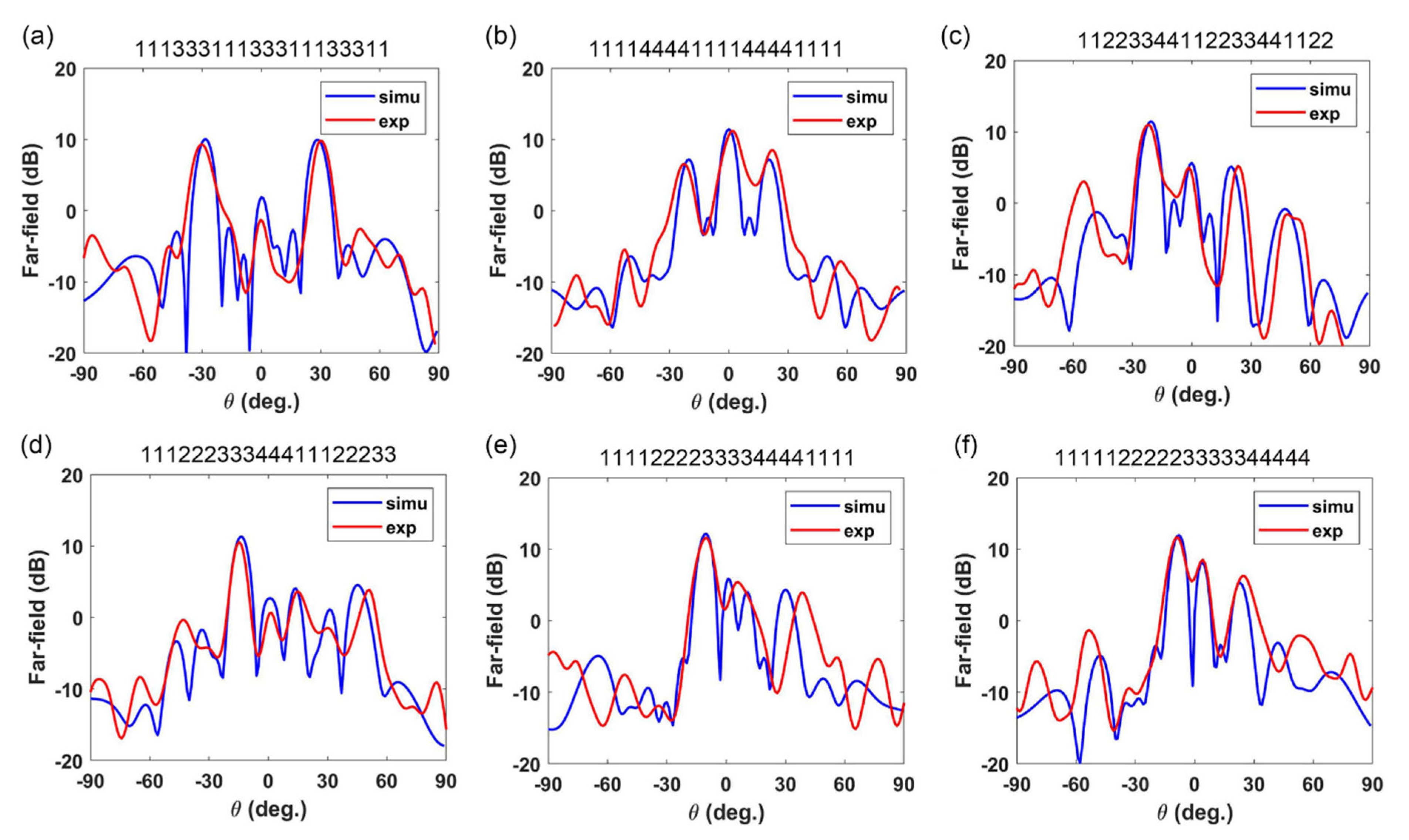
Publisher’s Note: MDPI stays neutral with regard to jurisdictional claims in published maps and institutional affiliations. |
© 2022 by the authors. Licensee MDPI, Basel, Switzerland. This article is an open access article distributed under the terms and conditions of the Creative Commons Attribution (CC BY) license (https://creativecommons.org/licenses/by/4.0/).
Share and Cite
Hao, J.; Ye, F.; Ruan, Y.; Chen, L.; Cui, H. Hilbert-Coding Metasurface for Diverse Electromagnetic Controls. Materials 2022, 15, 5913. https://doi.org/10.3390/ma15175913
Hao J, Ye F, Ruan Y, Chen L, Cui H. Hilbert-Coding Metasurface for Diverse Electromagnetic Controls. Materials. 2022; 15(17):5913. https://doi.org/10.3390/ma15175913
Chicago/Turabian StyleHao, Jianjiao, Fuju Ye, Ying Ruan, Lei Chen, and Haoyang Cui. 2022. "Hilbert-Coding Metasurface for Diverse Electromagnetic Controls" Materials 15, no. 17: 5913. https://doi.org/10.3390/ma15175913
APA StyleHao, J., Ye, F., Ruan, Y., Chen, L., & Cui, H. (2022). Hilbert-Coding Metasurface for Diverse Electromagnetic Controls. Materials, 15(17), 5913. https://doi.org/10.3390/ma15175913





